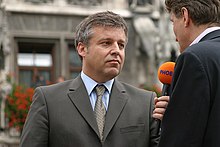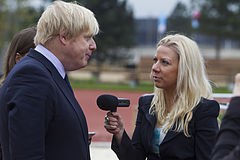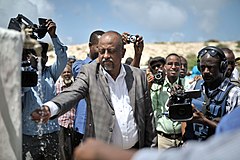Journalism is the production and distribution of reports on the interaction of events, facts, ideas, and people that are the "news of the day" and that informs society to at least some degree of accuracy. The word, a noun, applies to the occupation, the methods of gathering information, and the organizing literary styles.
Freedom of the press or freedom of the media is the fundamental principle that communication and expression through various media, including printed and electronic media, especially published materials, should be considered a right to be exercised freely. Such freedom implies the absence of interference from an overreaching state; its preservation may be sought through the constitution or other legal protection and security. It is in opposition to paid press, where communities, police organizations, and governments are paid for their copyrights.
Investigative journalism is a form of journalism in which reporters deeply investigate a single topic of interest, such as serious crimes, racial injustice, political corruption, or corporate wrongdoing. An investigative journalist may spend months or years researching and preparing a report. Practitioners sometimes use the terms "watchdog reporting" or "accountability reporting".

The Newseum was an American museum at 555 Pennsylvania Avenue NW dedicated to news and journalism that promoted free expression and the First Amendment to the United States Constitution, while tracing the evolution of communication.

Reporters Without Borders is an international non-profit and non-governmental organization focused on safeguarding the right to freedom of information. It describes its advocacy as founded on the belief that everyone requires access to the news and information, in line with Article 19 of the Universal Declaration of Human Rights that recognises the right to receive and share information regardless of frontiers, along with other international rights charters. RSF has consultative status at the United Nations, UNESCO, the Council of Europe, and the International Organisation of the Francophonie.

The Committee to Protect Journalists (CPJ) is an American independent non-profit, non-governmental organization, based in New York City, with correspondents around the world. CPJ promotes press freedom and defends the rights of journalists. The American Journalism Review has called the organization, "Journalism's Red Cross." Since the late 1980s CPJ has been publishing an annual census of journalists killed or imprisoned in relation to their work.
Radio Free Asia (RFA) is a United States government-funded private non-profit corporation operating a news service that broadcasts radio programs and publishes online news, information, and commentary for its audiences in Asia. The service, which provides editorially independent reporting, has the stated mission of providing accurate and uncensored reporting to countries in Asia that have poor media environments and limited protections for speech and press freedom and "advancing the goals of United States foreign policy."
In journalism, a source is a person, publication, or knowledge of other record or document that gives timely information. Outside journalism, sources are sometimes known as "news sources". Examples of sources include but are not limited to official records, publications or broadcasts, officials in government or business, organizations or corporations, witnesses of crime, accidents or other events, and people involved with or affected by a news event or issue.
Journalistic ethics and standards comprise principles of ethics and good practice applicable to journalists. This subset of media ethics is known as journalism's professional "code of ethics" and the "canons of journalism". The basic codes and canons commonly appear in statements by professional journalism associations and individual print, broadcast, and online news organizations.
Claims of media bias generally focus on the idea of media outlets reporting news in a way that seems partisan. Other claims argue that outlets sometimes sacrifice objectivity in pursuit of growth or profits.
The Sunday World is an Irish newspaper published by Independent News & Media. It is the second largest selling "popular" newspaper in the Republic of Ireland, and is also sold in Northern Ireland where a modified edition with more stories relevant to that region is produced. It was first published on 25 March 1973. Until 25 December 1988 all editions were printed in Dublin but since 1 January 1989 a Northern Ireland edition has been published and an English edition has been printed in London since March 1992.
Independent media refers to any media, such as television, newspapers, or Internet-based publications, that is free of influence by government or corporate interests. The term has varied applications.
Source protection, sometimes also referred to as source confidentiality or in the U.S. as the reporter's privilege, is a right accorded to journalists under the laws of many countries, as well as under international law. It prohibits authorities, including the courts, from compelling a journalist to reveal the identity of an anonymous source for a story. The right is based on a recognition that without a strong guarantee of anonymity, many would be deterred from coming forward and sharing information of public interests with journalists.

Mass media in the Philippines consists of several types of media: television, radio, newspapers, magazines, cinema, and websites.

The mass media in Syria consists primarily of television, radio, Internet, film and print. The national language of Syria is Arabic but some publications and broadcasts are also available in English and French. While television is the most popular medium in Syria, the Internet has become a widely utilized vehicle to disseminate content. Transcending all available media, the government seeks to control what Syrians see by restricting coverage from outside sources. Publications and broadcasts are monitored by members of the government. All mass media outlets are under the supervision of the Ministry of Information. Third article of the 2013 Information Ministry guidelines stipulate that purpose of all media outlets is "to enlighten public opinion" in line with the ideological doctrines "of the Arab Socialist Ba’ath Party and the policy of the state".
Collaborative journalism is a growing practice in the field of journalism. One definition is "a cooperative arrangement between two or more news and information organizations, which aims to supplement each organization’s resources and maximize the impact of the content produced." It is practiced by both professional and amateur reporters. It is not to be confused with citizen journalism.
Journalistic interventionism "reflects the extent to which journalists pursue a particular mission and promote certain values". Journalists with a high interventionist attitude do not report neutrally and objectively but are engaged in the subjects they are reporting about. An interventionist reporting style aims at influencing public opinion. Moreover, "journalism cultures that follow an interventionist approach may act on behalf of the socially disadvantaged or as mouthpiece of a political party and other groups whose interest are at stake".
Journalism culture is described as a "shared occupational ideology among newsworkers". The term journalism culture spans the cultural diversity of journalistic values, practices and media products or similar media artifacts. Research into the concept of journalism culture sometimes suggests an all-encompassing consensus among journalists "toward a common understanding and cultural identity of journalism."

Safety of journalists is the ability for journalists and media professionals to receive, produce and share information without facing physical or moral threats.
Freedom of the press in India is legally protected by the Amendment to the constitution of India, while the sovereignty, national integrity, and moral principles are generally protected by the law of India to maintain a hybrid legal system for independent journalism. In India, media bias or misleading information is restricted under the certain constitutional amendments as described by the country's constitution. The media crime is covered by the Indian Penal Code (IPC) which is applicable to all substantive aspects of criminal law.













